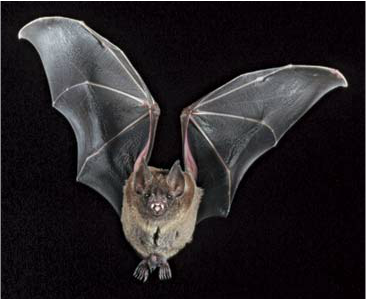|
by Elena Suglia '15  A bat's brain is functionally divided so that the right hemisphere informs navigation and the left processes communicative calls. [image via] A bat's brain is functionally divided so that the right hemisphere informs navigation and the left processes communicative calls. [image via] Most people know that bats use echolocation to find prey and orient themselves in space, but did you know that bats use echolocation to communicate with each other? It turns out that there’s music in the air every night, except we can’t hear it! It’s a good thing too, because the intensity of the sound waves bats create would be deafening could we hear them. A bat’s screech, though inaudible to us, “rivals the intensity of a revved-up engine of an aircraft about to take off” [1]. Think whale or dolphin song: that’s what bats do, except at super ultrasonic frequencies which human ears are unable to decipher. This makes intuitive sense when you consider what high- and low-pitched sounds are made of: sound waves with different frequencies. Sound waves with high frequencies bend less as they travel and can therefore be used in a more precise manner to target an object. Bats use higher frequency waves because they operate in tight spaces and need to be more aware of their immediate surroundings so that they don’t run into obstacles or lose track of a quickly moving, small insect [2]. Whales use lower frequency sound waves because they live in the open ocean, where they have much more space in which to maneuver.
0 Comments
by Jennifer Maccani, PhD  The painter Wassily Kandinsky was a well-known synesthete who saw music. [image via] If you’re a fan of classical music, you’ve likely spent a rhapsodic hour daydreaming to the lilting melodies of Beethoven’s sixth symphony, the “Pastoral,” so-named because the music is said to evoke images in the mind’s eye of rolling fields, fluttering streams, and tinkling birdsong. Yet, for roughly 0.05-1% of the population (1), Beethoven’s masterpieces can evoke far different—and far more vivid—imagery. For these people, music and/or other sensory stimuli trigger immediate perceptions that feel as real as the music itself, often in the form of color and shape (2, 3). These people were born with what some might consider a real-life superpower, a condition called synesthesia. The most common type is grapheme-color synesthesia, in which letters or numbers elicit colors in the mind’s eye. For synesthetes, these colors are an essential part of the letters or numbers themselves, almost a part of their essence or identity (4). However, over 60 types of synesthesia have been identified in the population; in fact, there may be 150 or more distinct types (5). Music can evoke spatial sensations, shapes or colors (6-8); words can taste sour or sweet (9); voices can look like grey smoke or dry, cracked soil (9, 10); or the sound of a car horn can smell like strawberries (11). Even the personalities of one’s family and friends can have their own distinct colors (12). Individuals may have only one type, or several, and some of them—such as voice-color and personality-color synesthesia—are rarer than others.
by Nari Lee '17
by Tiffany Citra ' 17  [image via] [image via] SciFiBusters is back! In the series’ first post, we went through Jules Verne’s scientific claims in 20,000 Leagues Under the Sea. Convinced that Verne deserves more than just a single post, I decided to dedicate yet another article about his other work that’s just as fascinating--Journey to the Center of the Earth. This book introduces its readers to the life of Axel, the nephew/assistant of a German scholar Professor Otto Lidenbrock. Axel’s life is pretty ordinary until the day his uncle discovers a cryptic text, which turns out to be written by a renowned Icelandic alchemist, Arne Saknussemm. Successfully deciphered by Professor Lidenbrock, the message contains directions to go beneath the surface of the Earth through the crater of Mount Sneffels, an inactive volcano in Iceland. Now let’s get down to the science. by Elena Suglia '15 Dolphins and other cetaceans are some of the most well-loved, charismatic creatures on Earth. This stems in part from the many human-like qualities they display. Some dolphins recognize themselves in a mirror [1], call each other by name [2], and correctly identify and communicate to humans the presence or absence of objects in their tank [3]. Their intelligence intrigues citizens and scientists alike, and cetaceans have earned a reputation as some of the world’s smartest animals. by Sarah Blunt '17  Artist’s depiction of a black hole interacting gravitationally with a nearby star and emitting jets of x-ray radiation. [image via] Artist’s depiction of a black hole interacting gravitationally with a nearby star and emitting jets of x-ray radiation. [image via] Have you ever wondered what a black hole looks like? Do you imagine an insatiable dark pit traveling through space, devouring everything in its path? Or do you imagine a tear in the fabric of space and time, replete with wormholes to other universes and the lifeless bodies of intrepid astronauts? Fueled in part by imaginative portrayals such as these, black holes have become a favorite astronomical conversation topic. The phrase “so massive that not even light can escape” has captured the imaginations of middle schoolers and professors alike, and scientists are anxious to find out more about these invisible gravitational behemoths. Dear reader,
Thank you for visiting Ursa Sapiens! We are back and ready to share scientific knowledge with you. Join the discussion by commenting or send us a pitch if you want to see your writing here. If you have any questions or suggestions, please feel free to contact us. Strap in -- the semester is in full swing and so are we! |

